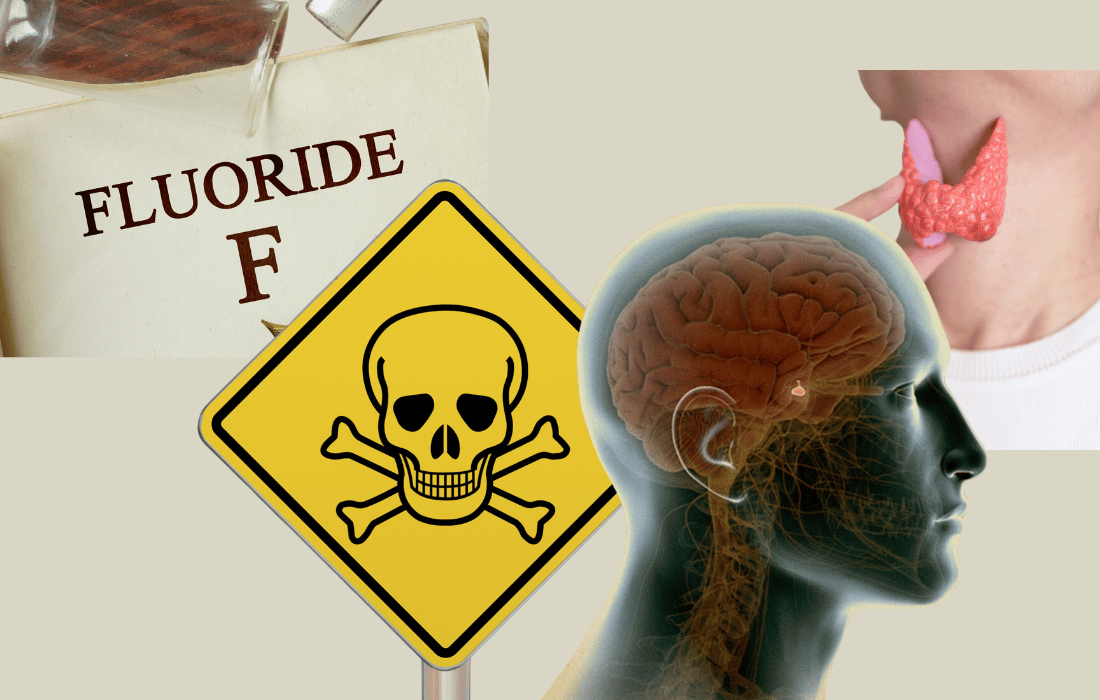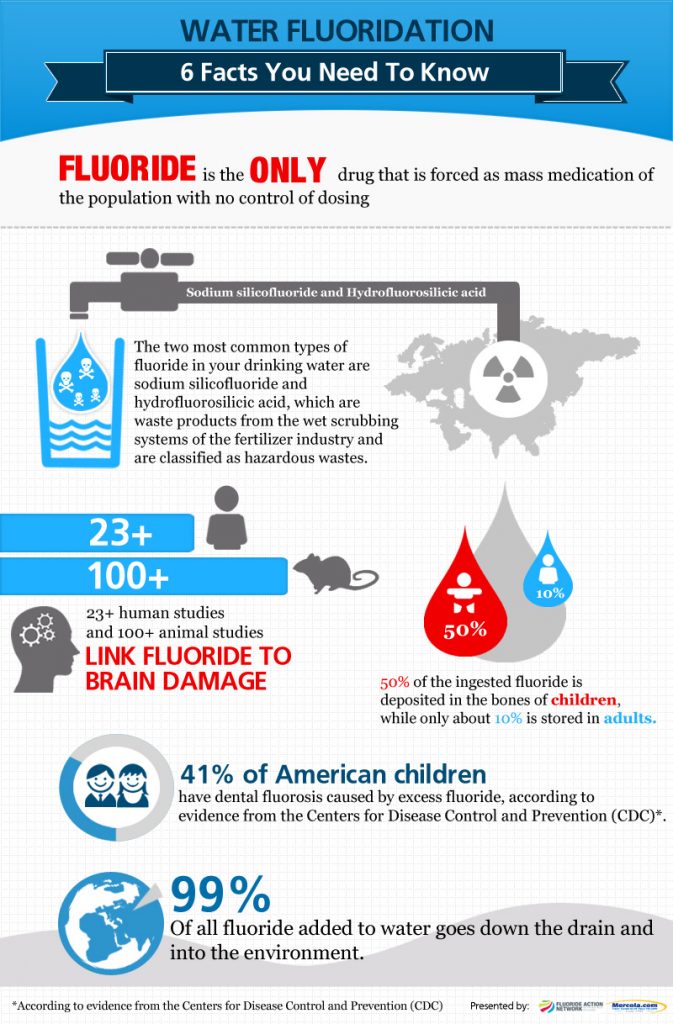Fluoride has long been heralded in mainstream media as a public health triumph, primarily for its supposed role in preventing tooth decay. Introduced into drinking water supplies across many countries, fluoride is celebrated by the majority as a simple and effective measure for improving dental health. However, this narrative glosses over a more complex and controversial story. As we dive deeper, we uncover a tale filled with industrial by-products, potential health risks, and the intersection of science and spirituality. This article explores the intricate history of fluoride, the propaganda surrounding its benefits, the scientific evidence linking it to various health concerns, and the critical need for safer water practices.
The Origins of Fluoride Use
From Rat Poison to “Public Health Miracle”
 The first widespread commercial use of fluoride was for the eradication of vermin. Since the 1800s, sodium fluoride has been a key ingredient in rat poison and insecticides. These products were commonly used in and around the home to kill lice, mice, rats, and insects. Fluoride proved to be not only a good way to kill rodents but also an effective way to kill humans when ingested in large quantities.
The first widespread commercial use of fluoride was for the eradication of vermin. Since the 1800s, sodium fluoride has been a key ingredient in rat poison and insecticides. These products were commonly used in and around the home to kill lice, mice, rats, and insects. Fluoride proved to be not only a good way to kill rodents but also an effective way to kill humans when ingested in large quantities.
Fluoride and Industrial Waste
During the Industrial Revolution, fluoride emerged as a byproduct of various industries, including aluminum production. Companies like Alcoa found themselves in a predicament as fluoride emissions began decimating local vegetation and livestock. Legal actions and damages reached into the tens of millions of dollars, creating a significant liability for these industries. The solution? Rebrand fluoride as a health benefit.
The Questionable Science Behind Fluoridation
The Mellon Institute and Alcoa’s Influence
Ironically, the US Public Health Service, under the jurisdiction of Treasury Secretary Andrew W. Mellon—a founder and major stockholder of Alcoa—endorsed fluoride. The Mellon Institute published evidence supporting fluoride’s effectiveness in fighting tooth decay. This questionable and self-serving data laid the groundwork for public water fluoridation.
The Grand Rapids Experiment

On January 25, 1945, Grand Rapids, Michigan, became the first city to publicly fluoridate its water supply. This experiment was meant to compare tooth decay rates with non-fluoridated Muskegon. However, the study’s integrity was compromised as it was unblinded, and Muskegon was later fluoridated, eliminating the control group. Despite these clear flaws, the experiment was hailed as a success and used to justify widespread fluoridation.
The Propaganda of Dental Benefits and the Reality
The promotion of fluoride as a dental health panacea is a prime example of how scientific findings can be influenced by economic and political interests. The fluoride added to public water supplies is not the same pharmaceutical-grade substance found in toothpaste but is often an industrial by-product from the phosphate fertilizer industry. This form of fluoride, known as fluorosilicic acid (FSA), contains impurities such as arsenic and lead, raising significant safety and ethical concerns.
The Myth of Fluoride’s Efficacy
The belief in fluoride’s effectiveness in preventing tooth decay has been a cornerstone of public health policy for decades. Proponents claim that fluoridated water reduces the incidence of dental caries by up to 60%. However, this statistic is based on early studies that may not fully account for other factors influencing dental health. Recent research suggests that the decline in caries rates is more likely attributed to improved dental hygiene practices, better access to dental care, and dietary changes rather than fluoride itself.
Comparative Studies and Global Perspectives
When comparing dental health across countries with varying fluoride practices, a more nuanced picture emerges. For example, many Western European nations, such as Germany, Sweden, and the Netherlands, have rejected water fluoridation. Despite this, these countries report similar or even lower rates of dental decay compared to the United States, where fluoridation is widespread. This comparison suggests that fluoride may not be as critical in preventing dental caries as once believed. Instead, other factors like overall dental care and public health initiatives play a more significant role.
The Role of Topical Fluoride
Another crucial aspect often overlooked in the debate over water fluoridation is the distinction between systemic and topical fluoride. While fluoride in toothpaste directly contacts teeth, providing a protective barrier, systemic fluoride (such as that ingested through drinking water) has a much less direct effect. The benefits of fluoride are primarily topical; they occur when fluoride is applied directly to the teeth rather than ingested. This distinction raises questions about the necessity and effectiveness of water fluoridation as a public health measure.
My two cents is to avoid fluoride altogether. While it may be a different form of fluoride that is in toothpaste, it is typically a much higher concentration and still dangerous to our health.
A Natural Alternative: VanMan’s Miracle ToothPowder
For those looking to avoid fluoride and still maintain excellent oral health, VanMan’s Miracle ToothPowder offers an effective alternative. This unique tooth powder has taken the internet by storm, not just for its effective cleaning but also for the vivid dreams reported by users—a result attributed to the lack of fluoride and the inclusion of high-quality minerals in the formula. The product promises a clean, fresh feeling without the “gross mouth” sensation often caused by commercial toothpaste foaming agents that disrupt natural saliva production.

VanMan’s Miracle ToothPowder is an all-natural product that can be used alone or as a booster to your favorite flavored toothpaste. Packaged in a sustainable glass jar with a metal cap, it offers over 200 uses, providing a 2-3 month supply when brushing twice daily. The ingredients include:
- Egg Shell Powder: Loaded with calcium and other minerals, egg shells are a natural source of hydroxyapatite, which can reverse early tooth decay.
- Bentonite Clay: This aged volcanic ash purifies, detoxifies, and alkalizes the mouth.
- Activated Coconut Charcoal: Detoxifies the mouth and whitens teeth.
- Baking Soda: Whitens and cleans teeth while alkalizing the mouth.
- Pink Himalayan Sea Salt: A natural bacteria killer that bonds to contaminants.
To use, wet your toothbrush, shake off the excess water, dip it into the powder for a light coating, and gently massage your teeth and gums. Finish with a swish and gargle for 5-10 seconds to circulate minerals and pull toxins from your mouth. It’s a simple yet effective way to keep your teeth healthy and your pineal gland clear.
Fluoride’s Impact on Thyroid Function
One of the less-discussed yet critical concerns about fluoride exposure is its potential impact on thyroid function. The thyroid gland regulates metabolism, and disruptions in its function can lead to significant health issues. Fluoride, being a halogen, can interfere with iodine absorption, an essential nutrient for thyroid health. This interference can potentially lead to conditions such as hypothyroidism.
Understanding the Thyroid Gland and Its Importance
The thyroid gland, located in the neck, produces hormones that regulate metabolism, energy production, and overall bodily function. Thyroxine (T4) and triiodothyronine (T3) are the primary hormones produced by the thyroid, and they play vital roles in maintaining metabolic rate, heart function, and digestive health. Any imbalance in these hormones can lead to a range of symptoms and disorders, highlighting the importance of maintaining thyroid health.
The Mechanism of Fluoride’s Impact on the Thyroid
Fluoride and iodine share similar chemical properties, making them competitive inhibitors for absorption in the thyroid gland. High fluoride intake can inhibit iodine uptake, leading to decreased production of T3 and T4 hormones. This can result in elevated levels of thyroid-stimulating hormone (TSH) as the body attempts to stimulate the thyroid to produce more hormones. Chronic exposure to fluoride, particularly in high concentrations, can consequently increase the risk of developing hypothyroidism, characterized by symptoms such as fatigue, weight gain, and depression.
Epidemiological Evidence and Studies
Numerous studies have investigated the relationship between fluoride exposure and thyroid function. A systematic review and meta-analysis revealed a positive correlation between high fluoride exposure and elevated TSH levels, indicating potential thyroid dysfunction. For example, a study conducted in India found that children living in areas with high fluoride concentrations in water exhibited significantly higher TSH levels compared to those in low-fluoride areas. Similarly, research from China demonstrated an increased prevalence of goiter and other thyroid disorders in regions with elevated fluoride levels.
The implications of these findings are particularly concerning given the rising incidence of thyroid disorders globally. Hypothyroidism, in particular, is a condition that can severely impact an individual’s quality of life, necessitating long-term medication and management. The potential contribution of fluoride exposure to this condition warrants further research and public health consideration.
Fluoride’s Impact on IQ and Brain Health
Recent research has raised concerns about the potential neurotoxic effects of fluoride, particularly its impact on children’s developing brains. Multiple studies suggest that high fluoride exposure may be associated with reduced IQ levels. For instance, a meta-analysis conducted by Harvard researchers reviewed 27 studies and found consistent evidence of an association between high fluoride exposure and lower IQ scores in children. The researchers noted that children in high-fluoride areas had significantly lower IQ scores than those in low-fluoride areas, raising alarms about fluoride’s potential neurotoxicity.
and found consistent evidence of an association between high fluoride exposure and lower IQ scores in children. The researchers noted that children in high-fluoride areas had significantly lower IQ scores than those in low-fluoride areas, raising alarms about fluoride’s potential neurotoxicity.
In addition to its potential impact on IQ, fluoride has also been linked to other neurological issues. A study published in Environmental Health Perspectives journal demonstrated that prenatal fluoride exposure could be associated with diminished cognitive function in children. The study measured maternal fluoride levels during pregnancy and found that higher levels were correlated with lower intelligence scores in their offspring at ages 4 and 6–12.
The Pineal Gland: The “Third Eye” and Its Fluoride Connection
Ah, the pineal gland—often referred to as the “third eye” by holistic health enthusiasts and affectionately dubbed so by the “holistic hippie” community. This small, pinecone-shaped gland has a reputation that straddles the line between scientific curiosity and mystical wonder. In the world of holistic health, the pineal gland is seen as a spiritual center, a gateway to higher consciousness, and a beacon of intuition. While these descriptions might seem far-fetched, the pineal gland indeed holds a unique place in human physiology, with a significant role in regulating sleep-wake cycles and producing melatonin.
Anatomy and Function of the Pineal Gland

The pineal gland is a tiny endocrine gland located in the brain’s center, nestled between the two hemispheres. It is primarily responsible for producing melatonin, a hormone that regulates sleep patterns and circadian rhythms. Melatonin is also a potent antioxidant, protecting cells from oxidative stress and damage. Unlike most other parts of the brain, the pineal gland is not protected by the blood-brain barrier, making it more susceptible to various substances, including fluoride.
The Pineal Gland as the “Third Eye”
The concept of the pineal gland as the “third eye” is not just a whimsical idea from holistic circles but has roots in ancient philosophies and spiritual traditions. The gland’s ability to regulate circadian rhythms and its sensitivity to light has led some to believe it plays a role in spiritual awakening and higher states of consciousness. While these claims are often met with skepticism by the scientific community, they underscore the unique nature of the pineal gland and its importance in human physiology.
Fluoride Accumulation and Calcification
Research has shown that the pineal gland can accumulate more fluoride than any other soft tissue in the body. This accumulation can lead to calcification, where calcium phosphate crystals form in the gland. A study conducted by Jennifer Luke in 2001 revealed that the fluoride content in the pineal glands of elderly individuals was significantly high, suggesting a link between fluoride exposure and gland calcification.
Calcification can reduce the gland’s ability to produce melatonin, leading to disrupted sleep patterns and various health issues. The decline in melatonin production can affect not only sleep but also mood, immune function, and overall well-being. Reduced melatonin levels have been associated with mood disorders, weakened immune function, and increased cancer risk. The potential impact of fluoride on the pineal gland thus extends beyond the realm of sleep, affecting multiple aspects of health.
The Intersection of Science and Spirituality
While the mystical aspects of the pineal gland as the “third eye” might seem esoteric, there is a fascinating intersection between ancient wisdom and modern science regarding this tiny gland. The pineal gland’s role in regulating circadian rhythms, its sensitivity to light, and its unique vulnerability to fluoride accumulation highlight its significance. The potential consequences of fluoride exposure, including reduced melatonin production and increased risk of neurodegenerative diseases, warrant further investigation and public awareness.
Supporting Pineal Health: Purium’s Pineal Clear
For those concerned about the health of their pineal gland, Purium’s Pineal Clear offers a scientifically formulated solution to support decalcification and overall well-being. This unique herbal tincture combines Organic Haritaki Fruit Extract, Organic Irish Sea Moss Extract, Organic Chaga Mycelium Extract, Organic Turmeric Root Extract, and Shilajit Extract. Together, these ingredients work synergistically to support healthy melatonin levels, a balanced inflammatory response, and the body’s natural detoxification processes.
Pineal Clear is designed to support the pineal gland’s natural function, helping maintain healthy sleep patterns and potentially enhancing spiritual awareness. The blend of ingredients promotes a natural and gentle approach to maintaining the gland’s health, free from synthetic additives or harmful substances. For more information on the benefits of Pineal Clear, you can read my detailed article, Maintaining Cognitive Function: Pineal Clear and Brain Health.
Beyond Dental Health: Other Potential Health Risks
While the most well-known concerns about fluoride revolve around dental health and thyroid function, emerging research suggests that fluoride exposure may have broader implications for human health. For instance, studies have indicated that fluoride can affect bone health, potentially increasing the risk of conditions like skeletal fluorosis, a disease characterized by joint stiffness and pain. This condition is more common in areas with high fluoride levels in drinking water, especially in developing countries.
Fluoride’s role as a neurotoxin has also been a subject of debate. Some studies suggest that high fluoride exposure can impair cognitive development in children. A meta-analysis conducted by Harvard researchers found that children in high-fluoride areas had significantly lower IQ scores compared to those in low-fluoride areas. While the evidence is not conclusive, it raises serious questions about the safety of long-term fluoride exposure, particularly during critical periods of brain development.
Moreover, fluoride has been linked to reproductive issues. Animal studies have shown that high fluoride levels can affect fertility and reproductive hormones. While more research is needed to understand these effects in humans, the existing evidence suggests that fluoride exposure could have far-reaching implications for reproductive health.
The Need for Water Purification and Safer Alternatives
Given the potential health risks associated with fluoride, it is crucial to consider safer alternatives and methods for reducing fluoride exposure. One of the most effective ways to remove fluoride from drinking water is through reverse osmosis (RO) systems. These systems use a semi-permeable membrane to filter out contaminants, including fluoride, providing clean and safe drinking water. The AquaTru countertop RO system, for example, can remove up to 99% of fluoride and other impurities, making it an excellent choice for households looking to minimize fluoride exposure.
 In addition to RO systems, other methods like activated alumina filters and distillation can effectively reduce fluoride levels in water. However, these methods can be more complex and less efficient than RO systems. Another option is to choose spring mineral water, which is naturally low in fluoride. However, it’s essential to verify the source and quality of the water to ensure it meets safety standards.
In addition to RO systems, other methods like activated alumina filters and distillation can effectively reduce fluoride levels in water. However, these methods can be more complex and less efficient than RO systems. Another option is to choose spring mineral water, which is naturally low in fluoride. However, it’s essential to verify the source and quality of the water to ensure it meets safety standards.
Conclusion
The history and use of fluoride in drinking water reveal a complex narrative filled with scientific debates, political interests, and ethical considerations. While fluoride has been promoted as a solution to dental caries, the potential risks to thyroid function, the pineal gland, and overall health cannot be ignored. The widespread practice of water fluoridation, often enforced without adequate public consultation, requires a thorough re-evaluation in light of emerging evidence.
While fluoride may have played a role in reducing dental decay in the past, the broader health implications suggest that it is time to reconsider its use in public water supplies. The precautionary principle should guide our approach, ensuring public health measures do more good than harm. By focusing on safer alternatives and promoting informed decision-making, we can better protect our health and the health of future generations.








